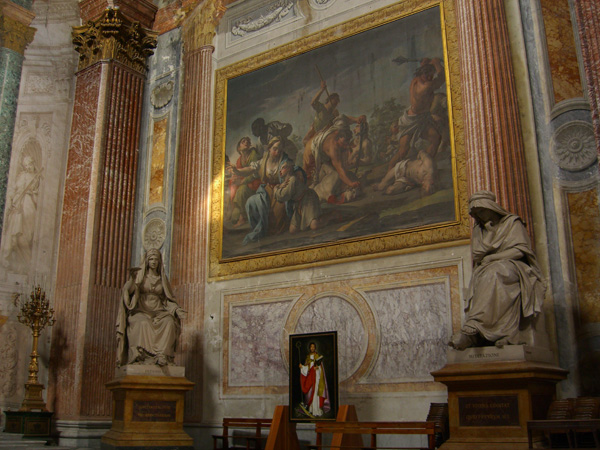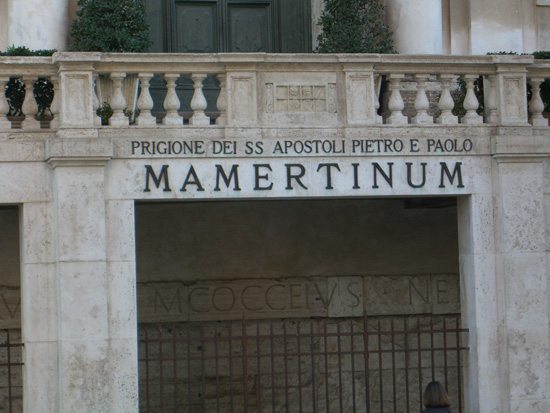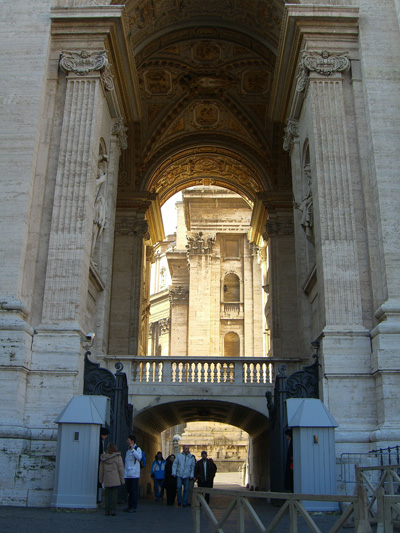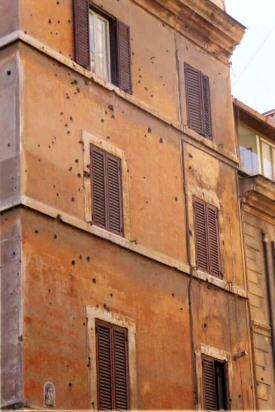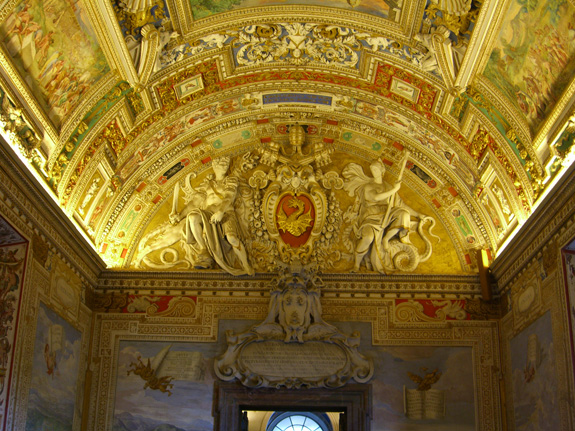YOUR FIRST THREE DAYS IN ROME: DAY ONE
Your first day in Rome is really only a half day since most flights land at Leonardo DaVinci between 7 and 10 in the morning. By the time you arrive at your hotel it is nearly noon. Opinions are deeply divided about what to do when you arrive. Some people climb right into bed after what was probably a sleepless night on the plane, while others bravely launch themselves full blast into the Roman day. A middle approach seems to work best.
After you check into your hotel I suggest you take a half hour to look around the neighborhood, then walk to Campo dei Fiori. It’s time to indulge in one of Rome’s great treats. Go to Forno (Campo dei Fiori 22) for several slices of their famous white or red pizza, and if you’re really hungry have them throw in a dessert (bring cash, no credit cards here). With pizza in hand walk around the Campo checking out the daily market. Don’t be afraid to talk to the merchants. Many speak a little English, and all Italians appreciate any attempt to try their language. A few Italian words go a long way and help get you into the Roman experience.
Check your watch, for it’s probably now coming up on 1 pm. This is when stores and most museums close (restaurants and snack bars of course stay open). It’s time to do as the Romans do, go home for a nap! You will notice that the city really slows down during this period and so should you, especially on your first day. Head back to your hotel, but before you go to the room ask the concierge to call the Borghese Gallery (Tel: 84241607, closed Monday) and make a reservation for later in the week. The concierge should also call tonight’s restaurant (Campana, see Roma Listings page for details) and tomorrow night’s (La Locanda di Bacco) for a reservation. Now head for your room, take a shower, set the alarm for 4pm and hit the sack. The nap brings you into the rhythm of the Roman day and night. Most restaurants do not open until 7:30 or 8 so without your siesta, at least on the first day, you’ll have trouble making it to dinner. The evening meal is one of the great Roman experiences and you do not want to nod off in the middle of the pasta course.
OK, it’s 4 pm! Rise slowly since you probably are wondering where you are. When it hits you that you’re in Italy put on some fresh clothes and get ready for the Roman evening. Ask for a map of Rome at the front desk then walk or take a taxi to the Piazza del Campidoglio. Walk up the grand staircase from the street level to the Piazza del Campidoglio, designed by Michelangelo. This is the center of ancient and modern Rome, the position of the former Temple of Jupiter.
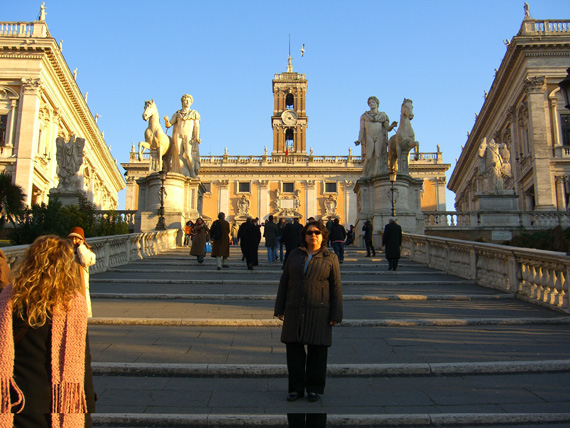
The yellow building straight ahead with the bell tower is the Palazzo Senatorio, the town hall, the mayor’s office. On Saturdays the piazza is filled with brides! If you feel the need for a cooling drink turn right at the top of the stairs and find the Caffe Capitolino, Piazzale Caffarelli 4, for a drink on the terrace while enjoying a view of all of Rome. After your drink return to the top of the stairs. In the center of the square is the bronze copy of the original Marcus Aurelius equestrian Roman sculpture now in the museum to your left. Walk straight ahead past Marcus Aurelius and proceed around the left side of Palazzo Senatorio for the world’s greatest view. Here you will see the ancient world as you can see it nowhere else!
Now descend to the Roman Forum. Before entering the Forum look in the church on your left (San Giuseppe dei Falegnami) for the Mamertine Prison. Here you can see an ancient Roman dungeon where the likes of Vercingetorix and Jugurtha were kept (St. Peter’s imprisonment here is only a legend).
Now proceed down the middle of the Forum on the Via Sacra toward the Colosseo. Halfway down the Forum is the Arch of Titus. Continue to the Colosseo.
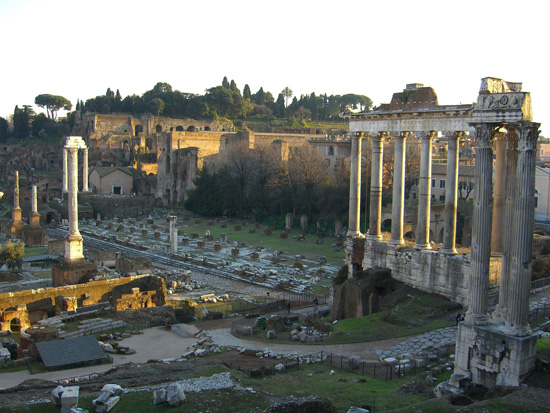
Resist the urge to go in the Colosseo but rather walk straight ahead along the right side of the Colosseo, cross the main road and continue along Via dei Santi for two blocks turning left onto Via Celimontana (turns into Via dei Normanni). After one block you will see the Basilica of San Clemente on your right. This three-level (underground) building is one of Rome’s most beautiful and unexpected discoveries. Count the sheep, doves and deer in the apse mosaic. Be sure to see both lower levels including the Mithraeum. Now it’s time to walk back to the hotel to prepare for dinner. If you are too tired to walk grab a taxi at the Colosseo.
Eating at table in Rome is one of the three great Roman experiences. The others of course are the people and the art. Tonight’s restaurant is a simple trattoria with classic Roman food. Think of eating out in Rome as your own opera in which you put together a performance in three acts. It’s especially appropriate only a few blocks away is the Church of San Andrea Della Valle where the first act of Pucinni’s Tosca was set.
Walk on stage at Campana around 8 pm. The first act is setting up the action: greet the maitre’d and the waiter with a cheerful “buona sera.” When the waiter brings the menu (la lista) ask for a bottle of mineral water (aqua or aqua gassata) and a bottle of house wine either red (vino rosso di casa) or white (vino bianco di casa). In Italy the meal consists of two plates : a first plate (primo piatto) usually a pasta or soup and a second plate (secondo piatto) of meat or fish. For your first plate I recommend the divine artichoke (carciofo) ravioli.
The second act begins with the arrival of the food. The waiter will proudly present the plates and offer grated cheese if appropriate. Gratefully acknowledge all this, complement his work (grazie! grazie!), and get to know him a little. Remember, it’s all an opera so enjoy yourself and use whatever Italian you know. Eat with a civilized flourish, you are in the center one of the world’s oldest cities where the great artists, composers, writers and Emperors have proceeded you. Now it’s your turn.
For the third act you have a choice to make. If you are comfortable staying where you are for coffee and dessert, just sit back and enjoy it. But if you are feeling well rested and are game for a big finishing act I suggest a romantic walk through the Roman night to see the Pantheon and to taste the city’s best ice cream (gelato) at Giolitti. The ten-minute walk is reminiscent of an opera in its dramatic nightlit setting. If you do stay at Campana for dessert be aware that in Rome the coffee will be brought only after you finish dessert. When you are ready to leave ask for the bill saying “Il conto, per favore.”
If it is a warm night sit in the Piazza before the Pantheon and sip an espresso. It’s a scene right out of Fellini with Agrippa and Hadrian’s glowing building serving as the mysterious backdrop for Rome’s passing parade. Imagine if you can (close your eyes and really try hard) the ancient Romans passing into the building or the scene when the obelisk was brought from Egypt.
Your final treat is only a few blocks away. With your back to the Pantheon proceed straight ahead on Via d. Pantheon for three blocks, turning right onto Via Uffici d. Vicario. You’ll see Giolitti straight ahead on your right (#40, open until 2am, closed Monday). Walk into the brightly lit gelateria and proceed toward the back for Rome’s best display of heavenly ice cream. When you have decided your flavor and cone size go back to the cashier and pay for your selection. Bring the receipt back to the counter person and select your flavors. The server will probably ask if you would like a little whipped cream (panna) on top and I doubt if you will decline. Enjoy your cone strolling through the night to your hotel. It’s time for bed, you have a full day tomorrow!
DAY TWO
We begin the day by greeting the cats of Rome! They are the local residents with the purest ancient bloodline. Proceed to the front of the Pantheon then walk down the left side along Via Minerva all the way to Corso Vittorio Emanuele (about 4 blocks). Cross the Corso to the Area Sacra D. Argentina, a sunken ancient forum with four temples. It was here that Ceasar was assassinated, not in the Roman Forum. Walk around the Area and see how many cats you count! This is one of two protected areas for the ancient felines (Largo Argentina, Sacra Dell’Argentina). After you circle the Area head up the Corso toward Piazza Navona. You will come upon the Church of San Andrea Della Valle on the left side of the Corso. It is in this church that the first act of Tosca takes place so humming a few lines from the opera may be appropriate. If you are a true opera buff then you must go inside.
Proceed straight across the Corso onto Corso del Rinascimento, go two blocks to the first cross road, turn left then right into Piazza Navona. Here in the center of old Rome is the ideal place to orient yourself to Roman space. Walk slowly around the Piazza. Check out the fountains, throw in a coin or two (backwards of course while making a wish), stop to watch the street performers or just sit on a bench and enjoy observing the Romans. When you’re ready for a surprise head out the east side of the Piazza (the street in the middle of the long side of the piazza nearest Bernini’s Four Rivers Fountain and in the direction back toward the Pantheon). You’ll know you’re on the right track because the short street leads directly to the Palazza Madama (directly in front of you across Corso del Rinascimento) where the Italian Senate meets. If you’re not too late in the morning also look for the police in period costumes at the main entrance.
Turn left on the Corso then immediately right onto Via d. Salvatore. Halfway down the block you’ll see a church on your left. Turn left at the end of the block and proceed into the Church of S. Luigi Dei Francesi. Walk up the left aisle to the last chapel on the left (Contarelli Chapel). It won’t look like much at first since you need some illumination, so drop a coin into the light box on the right pillar. Three Caravaggio paintings appear out of the gloom but the image on the left (the calling of St. Matthew) deserves your close attention. The painting captures the moment of total disbelief when Matthew the money changer is called by Jesus to join the disciples.The dramatic use of lighting effects in this oil painting marks the beginning of a revolution that deeply affected such artists as Rembrandt and Georges De Latour.
Head out of the church and proceed down Via Giustiniani (directly across the street and slightly to the right). About halfway down the block stop for a moment and consider this: you are about to see one of the history’s most important buildings. Now walk to the end of the street and look to your right. Before you is the Pantheon, the only classical Roman building still entirely intact. Look at it from a distance for a few moments. It sits sublimely in its Piazza, the perfect backdrop to a Roman stage set. Note the simple geometric forms of which it is composed (cube, sphere, cylinder) and how beautifully they are joined together into a harmonious whole.
Walk toward the porch stopping to note the tremendous scale of the structure. Roman buildings were meant to impress and intimidate. Go through the gigantic doors and behold the ancient Roman world as you can see it nowhere else. Here is the heavily veneered marble patterning Roman interior spaces were so famous for. Look up at the hole in the ceiling (oculus). If it is a sunny day imagine what happens when it rains! Check out Raphael’s tomb on the far left where admirers still leave flowers.
Walk out the door and proceed not quite straight ahead but slightly to the right toward the forked road taking the left fork to the Cafe d’Oro. Romans take a food break at about this time. In the cafe awaits one of Rome’s treats – the granita’ di cafe. Go to the cashier and pay for a granita, then take the receipt to the counter. The granita is a blissful layering of frozen espresso and whipped cream. It’s hard to describe but very easy to eat. This is also one of the best places for espresso in town.
Now, cup in hand walk up the left side of the Pantheon and notice the cats perched among the ruins. You’re probably starting to feel like a Roman as the granita slides down your throat and more ancient streets call. Just ahead in the center of the next piazza is Bernini’s playful elephant holding up an Egyptian obelisk. If you’re wondering why there so many obelisks in Rome remember that victorious armies had a bad habit of plundering the best from the vanquished and Egypt’s obelisks were a popular and relatively easy art form to bring home. The ancient Romans did the plundering first, followed by the Christians centuries later.
This piazza is named after the ancient temple of Minerva that once stood here. The large simple facade that forms the backdrop for the Piazza is the Church of Santa Maria Sopra Minerva and a good place to end our morning’s journey. Before entering note the wall plaques on the right facade that indicate the date and level of the major floods of Rome’s famous river the Tiber (Tevere).
Santa Maria Sopra Minerva is one of the rare Gothic spaces in Italy and the only one in Rome. Although the telltale pointed arches give away the style it is worlds away from the more familiar soaring gothic of France. Each building in Rome has its ghosts if you know where to look. In the chapter house of this church, Galileo endured the trial that nearly cost him his life. Under the high altar are the relics of St. Catherine and just a few yards to the left the poignant floor tomb of the divine Fra Angelico. Between the two, standing against a pillar, is one of Michelangelo’s sculptures, Christ Bearing The Cross. There are only a few sculptures by Michelangelo in the world (a handful in Rome and Florence, two in Paris, one in Milan and Bruges). Most interesting is the tremendous amount of clearing away of stone undertaken by Michelangelo’s assistants to separate the cross from Christ. No other work of his has this dramatic spatial separation of two objects. Take your time, poke around the chapels, sit down and close your eyes and listen to the sounds of the church.
Head back to the hotel, have lunch and a rest before the afternoon program begins. Most churches close until midafternoon so plan to set out again at about 3:30. After your rest take a taxi to Piazza S. Bernardo (near the intersection of Via XX Settembre and Largo Santa Susanna). Your destination is the Church of Santa Maria della Vittoria. (It’s always a good idea to have your hotel mark a map to show the taxi driver where you are headed.) Head into the church to see Bernini’s great work The Ecstasy of St Teresa of Avila (last chapel on the left). Read about this work in the guidebook before your visit. Proceed out the front door and turn right up Via XX Settembre to the first church, Santa Susanna. This is the American church of Rome. Go inside and ring the bell along the left wall. This is the gift shop (the nuns sell beautiful needle work) where you can see through the floor to the ruins of an ancient Christian residence. Walk back out the front door turning left then left again down Via Barberini to Piazza Barberini. When you reach Piazza Barberini turn right and go up Via Vittorio Veneto to the first church on the right, S. Maria D. Concezione (Via Vittorio Veneto 27). Do not go into the church but rather go up the steps to the right to the little museum and crypt (Museo e Cripta dei Frati Cappuccini). This will be one of your most interesting moments of the trip! Don’t miss this!!!
Walk back to Piazza Barberini and proceed down the right side toward Via del Tritone. Cross to the left side of Via del Tritone and turn left at Via Boccaccio. At the intersection of Via Boccaccio and Via Rasella cross to the far side of Via Rasella and look back at the houses across the street still marked with bullet holes. All Romans know this place, but very few tourists have ever seen it. This is site of the attack by Italian Resistance fighters against a column of 156 Nazi SS anti-Partisan Police (11th Company, 3d Bozen SS Battalion) at 3:45 PM on 23 March 1944. A highly recommended account of this assault and the Nazi occupation of Rome is found in The Battle For Rome, by Robert Katz, Simon & Schuster, 2003. This is a must read before a trip to Rome!
Go back to Via del Tritone and proceed down hill turning right onto Via Due Macelli at the first major intersection. This will take you to the Spanish Steps where you will turn left onto Via Condotti. It’s time for some heavy duty shopping! For the non-shopping types take a look in the Keats-Shelley House to the right of the Spanish steps. Return to the hotel in time for a rest before dinner at Santopadre, Via Collina 18.
DAY THREE
We begin the tour at 10:15 with a taxi ride out the ancient Appian Way to the Catacombs of San Callisto. This Catacomb is closed on Wednesday. You will be shown through the underground cemeteries by a guide. When you are finished take the short path out to the Appian Way and walk back along Via Appia Antica toward Rome or take a taxi that you have prearranged to pick you up.
After lunch take the taxi to the Borghese Gallery. On your first day you made a reservation for the Borghese Gallery, yes? Begin on the top floor (mainly paintings) keeping the best for last. When you descend to the first floor you will be in the sculpture collections. Hopefully, the last room you come to will contain the Bernini sculpture Apollo and Daphne. Spend at least twenty minutes with this sculpture, it is one of the world’s great masterpieces. When you are finished take a slow walk through the park toward Porta Pinciana and Via Veneto. Descend Via Veneto turning right on Via Ludovisi. Walk to the end of Via Ludovisi turn left down Via F. Crispi and right onto Via Sistina. At the end of Via Sisitina you will find yourselves at the top of the Spanish Steps. Just behind you is the Hotel Hassler. If the roof bar is open I suggest you take the elevator to the top of the Hassler for a drink and spectacular view.
Tonight’s dinner choices:
CESARINA (see Roma Listings), if you want to enjoy a quiet night eating as the Romans do. If you go be sure to order the mixed pasta plate (4 different types of pasta).
RISTORANTE L’ORSO 80, if you want a boisterous last night out in Rome.
